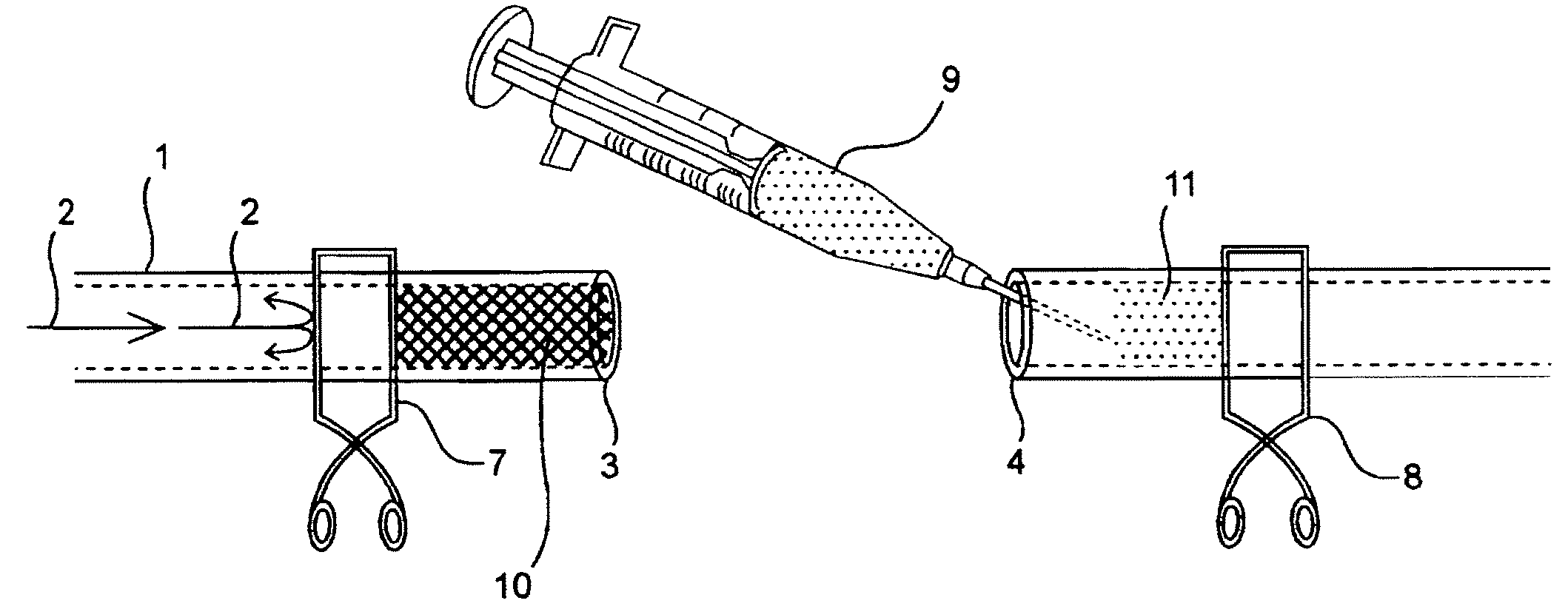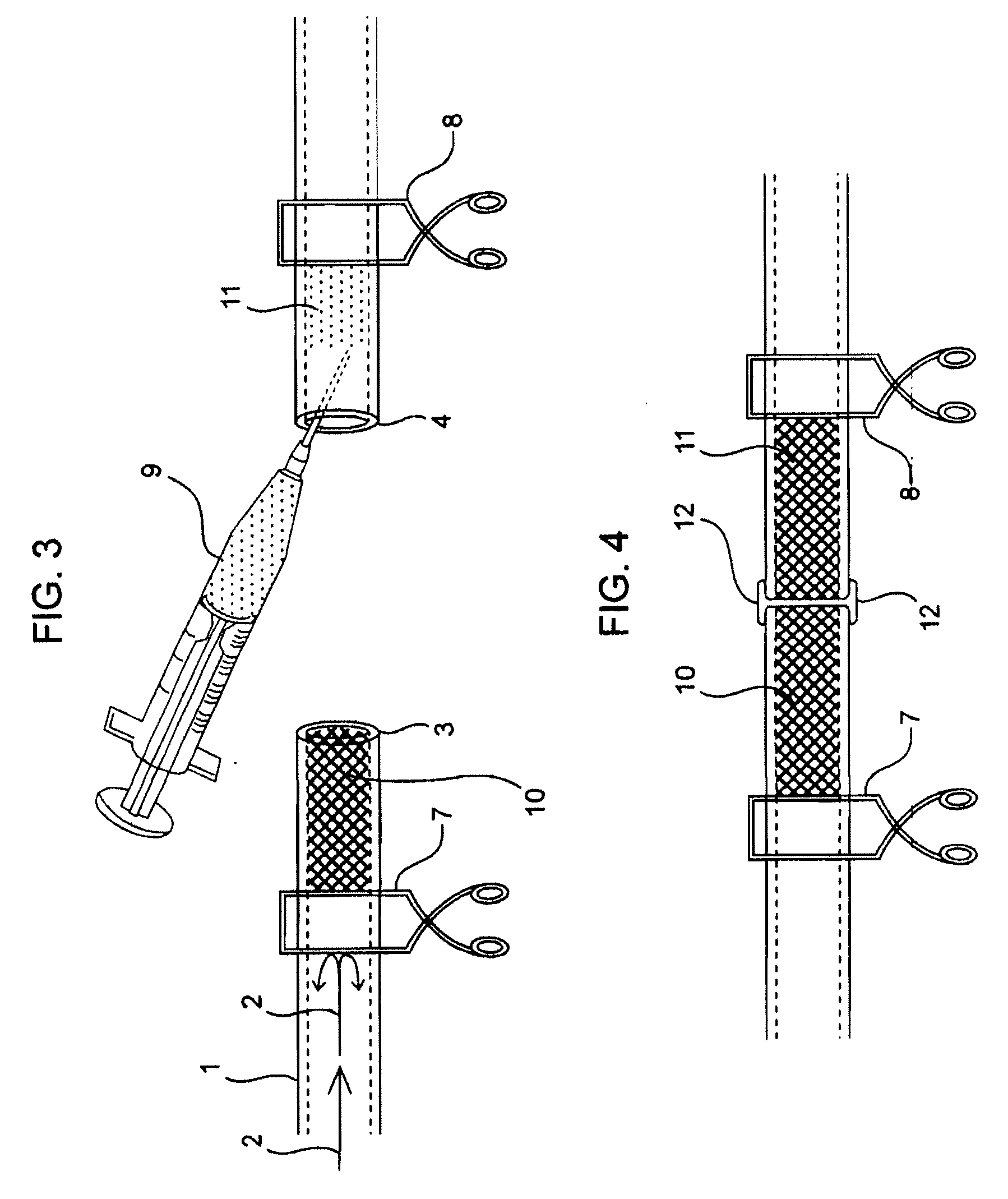Compositions and methods for joining non-conjoined lumens
- Summary
- Abstract
- Description
- Claims
- Application Information
AI Technical Summary
Benefits of technology
Problems solved by technology
Method used
Image
Examples
example 1
Preparation and Property Determination of a Sol-Gel Composition of this Invention
[0282]Presented here is a protocol for preparing 100 mL (100 g) of a thermoreversible sol-gel composition of this invention.
[0283]Materials:[0284]Phosphate buffered saline (“PBS”): 64 g, pH 7.4, with Ca2+ and Mg2+;[0285]Poloxamer 407 (BASF Pluronic® F 127): 14.4 g;[0286]Poloxamer 188 (BASF Pluronic® F 68): 21.6 g.
[0287]Procedure:
[0288]The above materials were mixed at 4° C. under high shear to facilitate dispersing the solid poloxamer in the solvent. The heterogenous mixture is then rocked at 0.5 Hz and 4° C. for at least 12 hours to allow for complete dissolution of the poloxamer in the solvent. The mixture is then further stirred to ensure homogeneity.
[0289]Water or other aqueous solutions may replace PBS as the solvent. It is preferred that the solvent has an ionic concentration and pH that are close to that of the body fluid so that the resulting thermoreversible sol-gel compositions do not cause su...
example 2
Anastomosis Procedure Using a Sol-gel and Cyanoacrylate Glue
[0295]Dogs, which were treated and cared for in accordance with all applicable laws and regulations, and in accordance with good laboratory practices, were anesthetized and placed in dorsal recumbency. The femoral artery and vein were exposed bilaterally, and the peri-adventitial tissues on both artery and vein were cleaned off at the site of anastomosis. Two clamps were placed on the artery, distal and proximal to the target vessel site, and one clamp was placed on the vein, proximal to the target vessel site. The vein was ligated and incised distally and an arteriotomy was made with an arteriotomy punch. The target vessels were flushed with heparinized saline to remove blood and the vessel ends were approximated with four stay sutures. The surgical area was heated to about 35-45° C. and a sol-gel composition of this invention was warmed to about 35-45° C. A sol-gel composition, Composition 2, was injected into the lumens ...
example 3
Anastomosis Procedure Using a Sol-Gel and Biological Glue
[0296]Dogs, which were treated and cared for in accordance with all applicable laws and regulations, and in accordance with good laboratory practices, were anesthetized and placed in dorsal recumbency. The femoral artery and vein were exposed bilaterally, and the peri-adventitial tissues on both artery and vein were cleaned off at the site of anastomosis. Two clamps were placed on the artery, distal and proximal to the target vessel site, and one clamp was placed on the vein, proximal to the target vessel site. The vein was ligated and incised distally and an arteriotomy was made with an arteriotomy punch. The target vessels were flushed with heparinized saline to remove blood and the vessel ends were approximated with four stay sutures. The surgical area was heated to about 35-45° C. and a sol-gel composition of this invention was warmed to about 35-45° C. A sol-gel composition, Composition 2, was injected into the lumens of ...
PUM
| Property | Measurement | Unit |
|---|---|---|
| Fraction | aaaaa | aaaaa |
| Fraction | aaaaa | aaaaa |
| Fraction | aaaaa | aaaaa |
Abstract
Description
Claims
Application Information
 Login to View More
Login to View More - R&D
- Intellectual Property
- Life Sciences
- Materials
- Tech Scout
- Unparalleled Data Quality
- Higher Quality Content
- 60% Fewer Hallucinations
Browse by: Latest US Patents, China's latest patents, Technical Efficacy Thesaurus, Application Domain, Technology Topic, Popular Technical Reports.
© 2025 PatSnap. All rights reserved.Legal|Privacy policy|Modern Slavery Act Transparency Statement|Sitemap|About US| Contact US: help@patsnap.com



